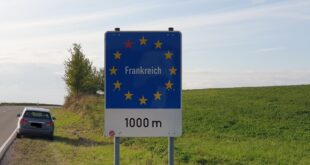The Schengen area comprises of European countries that have abolished passport and all other types of border control at their mutual borders. The area mostly functions as a single jurisdiction for international travel purposes, with a common visa policy.
The Schengen Agreement, which seeks to create a single European territory devoid of internal borders, was signed by five European Union member states – Belgium, Germany, France, Luxembourg and the Netherlands – on 14 June 1985.
The treaty was named after Schengen, the small village in Luxembourg that is located on the point where its borders meet those of Germany and France where it was signed.
The Schengen Agreement abolishes internal borders, checkpoints and controls, enabling passport-free movement between the signatory countries.

The convention implementing the Schengen Agreement entered into force on 25 March 1995 and border controls were abolished between Belgium, Germany, Spain, France, Luxembourg, the Netherlands and Portugal (Spain and Portugal had signed the Agreement in June 1991).
The 26 countries that are currently members of the Schengen Agreement are Austria, Belgium, Czech Republic, Denmark, Estonia, Finland, France, Germany, Greece, Hungary, Iceland, Italy, Latvia, Liechtenstein, Lithuania, Luxembourg, Malta, Netherlands, Norway, Poland, Portugal, Slovakia, Slovenia, Spain, Sweden, and Switzerland.
Twenty-two of these are EU members. Liechtenstein, Switzerland, Iceland and Norway are not members of the EU. So, they are officially known as the countries that are associated with the Schengen activities of the EU.
De facto, the Schengen area also includes several microstates — Monaco, San Marino and the Vatican City — that maintain open or semi-open borders with Schengen countries. Apart from these countries, the Schengen area also includes the Caribbean islands that belong to France.
There are six EU members that have not yet joined the Schengen Area: Ireland and United Kingdom negotiated opt-outs from the Agreement and Romania, Bulgaria, Croatia and Cyprus are required to and are seeking to join soon.
The Schengen Agreement offers freedom of movement to some 400 million EU citizens, who can cross internal borders within the Schengen Area freely and without need to carry a passport. Non-EU citizens can obtain a Schengen visa that allows them to move freely within the Schengen area.
Femi Awoniyi
 THE AFRICAN COURIER. Reporting Africa and its Diaspora! The African Courier is an international magazine published in Germany to report on Africa and the Diaspora African experience. The first issue of the bimonthly magazine appeared on the newsstands on 15 February 1998. The African Courier is a communication forum for European-African political, economic and cultural exchanges, and a voice for Africa in Europe.
THE AFRICAN COURIER. Reporting Africa and its Diaspora! The African Courier is an international magazine published in Germany to report on Africa and the Diaspora African experience. The first issue of the bimonthly magazine appeared on the newsstands on 15 February 1998. The African Courier is a communication forum for European-African political, economic and cultural exchanges, and a voice for Africa in Europe.


































